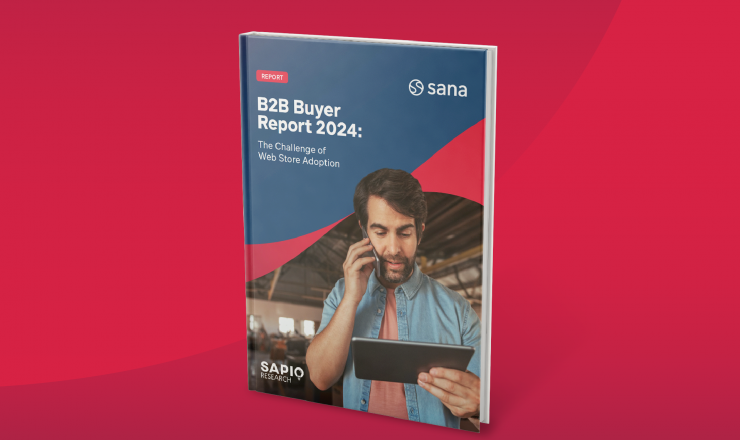

Selling online in the B2B world is a different ball game than B2C. Forget impulse buys — B2B buyers are all about strategy. So how can you price your products to win them over?
Transparency is key
Unlike B2C, where emotions can drive purchases, B2B decisions are built on long-term value. What this means for you: be upfront about pricing. According to a recent B2B Buyer Report, 55% of B2B buyers need to see pre-negotiated prices readily available, and 94% expect clear payment options.
Are pricing strategies necessary in B2B e-commerce?
When you hear the term “pricing strategy”, it’s simple enough to think immediately of discounts. However, the reality is a little more complicated, and based on what your buyers are looking for. According to our B2B Buyer Report, customers want full visibility on pricing as they’re making purchase decisions. 55% of B2B buyers say that they need to see their business’ agreed prices with their suppliers when ordering online, while 94% state they also need information on their agreed payment rules and methods.
It’s clear that transparency is a crucial part of an effective B2B e-commerce pricing strategy. What’s more, a well-defined pricing strategy can help you:
- Stay competitive: Attract and retain customers by offering prices aligned with the market.
- Communicate value: Clearly demonstrate the worth of your products and justify their cost to buyers.
- Optimize sales: Tailor pricing to different customer segments and sales goals.
- Boost profitability: Ensure your pricing reflects your costs and allows for healthy margins.
5 Pricing Strategies to Drive B2B Sales
Let’s explore some winning B2B e-commerce pricing strategies to elevate your online presence and achieve your sales goals:
- Stay competitive: Analyze your competitor’s pricing. This helps you stay relevant, especially in price-sensitive markets. But remember, B2B buyers value relationships. If you offer superior value, you can sometimes command a premium.
- Focus on value: Price your products based on the problem you solve, not just production costs. Understand your customer’s needs and how much they’d pay to solve them. Clear product descriptions and a customer journey that highlights your value proposition are essential here.
- Price skimming (for new products): This strategy lets you charge a premium for new products when they launch, then gradually lower prices to reach budget-conscious buyers later. It can help recoup development costs and position you as a premium brand.
- Penetration pricing (for new stores): Attract new customers and gain market share quickly by offering introductory low prices. This is a good strategy for new online stores or those with a digital-first approach. While margins might be slim, it can generate high sales volume to break even and reach targets.
- Bundle pricing: Package complementary products together at a discounted price. This entices customers to buy more and helps you manage inventory and boost cross-selling opportunities.

Successful e-commerce starts with a plan.
Watch our 20-minute webinar to get started with yours.
Choosing the Right Strategy
Here’s what to consider when selecting the best pricing strategy for your B2B e-commerce business:
- Competitor analysis: Understand industry pricing trends to identify potential gaps or areas where you can offer unique value.
- Cost awareness: Know your fixed costs (rent, salaries) and variable costs (materials, labor, shipping) to price effectively.
- Define your goals: Are you aiming for maximum profit, market share growth, or brand positioning? Align your pricing strategy with these objectives.
- Understand customer motivations: What drives your customers to buy? Is it perceived value, solving a pain point, or post-sale support?
Common pricing strategy pitfalls to watch out for
Pricing strategies play a crucial role in a company’s profitability and market position. However, even the best strategies can become ineffective if common pitfalls aren’t avoided. Here are some of the most prevalent pricing strategy pitfalls businesses should be wary of:
- Underestimating your costs: Failing to account for all costs, both direct and indirect, can lead to prices that are too low to sustain the business.
- Ignoring the competition: While you shouldn’t base your entire strategy on competitors, being oblivious to their pricing can be detrimental.
- Devaluing your brand: Constant discounts or aggressive low-price strategies can erode the perceived value of a product or brand.
- Failing to communicate value: If customers don’t understand the value behind a product or service, they may perceive it as overpriced.
- Ignoring customer segments: Recognizing the different needs and willingness to pay among customer groups and adjusting pricing or offers accordingly can optimize revenue.
The potential of the right pricing strategy for your business
Mastering the art of e-commerce pricing is no small feat. As we’ve explored, each strategy—be it competitor-based, value-driven, skimming, penetration, or bundling—comes with its unique set of benefits tailored for specific business goals and market conditions. The challenge lies not just in picking the right strategy, but also in deftly sidestepping the common pitfalls that can undermine even the most well-thought-out approaches.
By understanding your costs, defining clear objectives, and keeping a keen eye on what truly motivates your customers, you can harness the power of pricing to drive conversions and secure a competitive edge in the bustling digital marketplace.

How well do you know your B2B buyers?
Find out with the latest market data on professional buyers around the world.



